Summary
Current and planned research projects related to this plot
- Improving methodologies for measuring stem-flow in forest plots
- Investigation of canopy throughfall and interception
- Monitoring canopy exposure to ozone
- Straits’ flux station
- Woodland burial studies
- Soil mineral weathering rates
- Environmental change network
- Further development and implementation of an EU-level forest monitoring system (FutMon)
Measurements
A summary of the variables monitored at this site can be found here.
Plot description
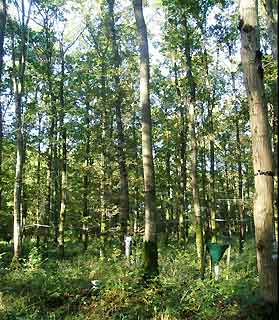
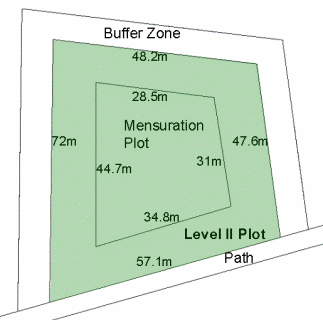
| Date of installation | 02/06/1994 |
|---|---|
| Planting year | 1935 |
| Main tree species | Oak (Quercus robur) |
| Other tree species present in plot | 10% Ash (Fraxinus excelsior) |
| Forest type | Plantation (native species) BEAR code 33; NVC Category W10 Quercus robur – Pteridium aquilinum – Rubus fruticous |
| Sylvicultural system | Uniform system with thinning cycles of 5 to 10 years |
| Tree density | 385 trees/ha (2005) |
| Biomass/volume | 194.2 m3/ha (2005) |
| Basal area | 21.35 m2/ ha (2005) |
| Local Yield Class | 6 |
| Plot dimensions | 0.29 ha |
| Altitude | 80 m |
| Mean slope | 0% |
| Geology | Clay-calcareous |
| Topography | Uneven, some dips and mounds |
| Aspect | None – flat ground |
| Rainfall | 798 mm per annum (Annual mean 1954 to 2004) |
| Provisional soil type (FAO 1988) | Eutric vertisol |
Surrounding habitat
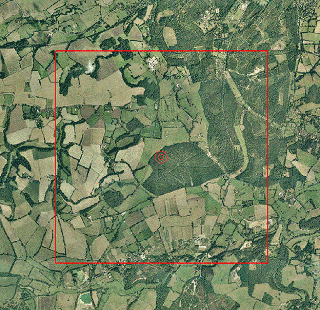
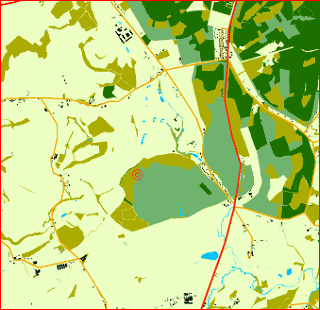
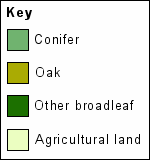
Management history
Pre-1066
- Alice Holt forest probably originated in the Atlantic period (5500 BC – 2600 BC) with Pedunculate oak emerging as the main tree species (Dixon, 1956). Humans lived in the environs of the forest from Lower Paleolithic times hunting game and using timber for fuel and for constructing buildings (FC, 1951).
- From the first century AD until around AD 500 the Gault clay of the forest was used by the Romans for pottery, brick and daub. The Roman-Britons must have carried out large fellings, in part to fire kilns and make space for dwellings. Apart from a number of archaeological finds, however, there is little historical information relating to the forest of this period, making it difficult to accurately describe the condition of the forest (FC, 1951).
- During the Anglo-Saxon period the forest recovered, and became a sanctuary for wildlife such as red, roe and fallow deer, wild boar, fox, martens, wild cats and possibly bear and wolf. The various Teutonic invaders, Saxons, Angles, Jutes and Frisians depended mostly on their herds and flocks, which fed on the herbage and mast of the woodlands. The forests during this period were state owned and as such, known as ‘folk land’ (Dixon, 1956).
- Under later Saxon rule, husbandry gained in importance and an increasing proportion of woodland was felled and cleared of trees and fenced off to keep wild animals at bay. As more and more land was cultivated, animals were driven into the least accessible parts of the forests. These sections of the woods were increasingly favoured over this period for game and were acquired by powerful individuals (Dixon, 1956); i.e. Alice Holt forest is thought to have belonged to the See of Winchester (Whiteman, 1977). Roe deer were persecuted over this period, while fallow deer were a favoured game species.
1066 to 1800
- After the Norman conquest (1066), Alice Holt Forest reverted to the Crown. The forest became a Royal hunting ground, or ‘chase’ and was managed for the preservation of ‘vert and venison’ with strict punishments for the infringement of forest laws. By Tudor times (1485-1558), hunting had, however, largely faded (Whiteman, 1977).
- The earliest known survey of Alice Holt woods was made in 1171 for Henry II. Another was made in 1300 during the reign of Edward II, although no detailed record of the woods condition was given in either. A much later survey in 1635 during the reign of Charles I suggests that the forest contained mostly oak with some beech and ash. Nearly all stands were described at this time as being ‘of full growth and decaying’ (Kitchingham, 1955).
- There is evidence that the woods were well managed in the latter part of the 17th century, but subsequently suffered a long period of neglect in the 18th century (FC, 1951; Ryle, 1969). The red deer had been removed to Windsor by 1760 and in 1777 there was an estimate of 800 fallow deer present in Alice Holt forest. In 1783 an estimated 38,920 oak trees were present in Alice Holt. 1,000 of these were removed in 1784 as timber for the Navy (Dixon, 1956).
- In 1790 a fourth survey, known as the Middleton Report, produced an estimate of the value of all oak timber in Alice Holt forest and a rudimentary map (Kitchingman, 1955). The Middleton Report recommended ‘the felling of all timber that is fit for the Navy’, which suggests that little big timber was left behind by the end of the 18th century.
1800 to 1900
- In 1812 an Act was passed for the ‘better cultivation’ of Navy timber in the Forest of Alice Holt. Under its authority, deer were removed, and 1600 acres were enclosed by the Crown. This area was cleared of a mature crop of oak with some beech and ash and planted with even-aged stands of oak between 1815 and 1825. Trees were grown wide apart when young to produce the large branches on trunks that were much in demand by the Navy. The Office of Woods later undertook regular and heavy thinnings (FC, 1951; Kitchingman, 1955; Rackham, 1990).
- In 1871 an old map shows a mixed plantation (Landmark Information Group). The wide planting strategy of the early 1800s had some negative consequences for older unmanaged stands when tree crowns closed up and lower branches died. These lower branches tended to be attacked by pipe rot fungus (Stereum gausapatum).
- In 1881 some of the poorer parts of the 1815-1825 oak crop were cleared away, and these areas were replanted with conifers. A working plan of the forest was devised by Sir William Schlich in 1903. The plan classified the oak woods into three quality classes by height growth at 80 years of age. The Straits’ enclosure was categorised as ‘first class’ timber (mean height of 60ft. and over). Schlich’s plan was to gradually change a proportion of the forest to conifer, although this plan proceeded very slowly.
Post 1900
- In 1918 the need for home-grown timber was high following the war and heavy felling occurred. Mr. R.L. Robinson intervened and revised the plans laid out by Sir Schlich. Mr. Robinson favoured the maintenance of oak in the forest and he describes the ‘oak circle’ (including the Straits’ enclosure) as 80-100 year-old oak with occasional ash and conifers (FC, 1951; Ryle, 1969).
- Alice Holt forest was acquired by the Forestry Commission in 1924 and, after this, the second world war saw a steep decline in the number of trees measured for girth with some 134 acres of old oak felled and quickly replanted (FC, 1951; Ryle, 1964).
- The present oak stand comprising the Level II plot was planted in 1935 (01/01/1935).
- In 1991 the Level II oak plot was thinned. It was thinned again in 1994 (19 m3/ha removed, or 156 trees /ha), in 2001 (32 m3/ha removed, or 110 trees /ha) and again in 2004 (51 m3/ha removed, or 110 trees /ha).
- At present roe deer are the main large herbivores in Alice Holt forest and these are thought to have migrated from Windsor in the middle of the 20th century. Muntjac may also be present in small numbers. Although present in small numbers in 1938 and in 1947, Fallow deer are not thought to occur at present in Alice Holt Forest (Taylor, 1947).
References
Dixon, W.H. (1956). Historical notes on the forests of Alice Holt and Woolmer. Journal of the Forestry Commission. 25: 58-71.
Forestry Commission. (1951). History of Alice Holt Forest. South East (England) Conservancy.
Kitchingman, G.D. (1955). Alice Holt Forest: Contributions to its history. Journal of the Forestry Commission. 24: 29-32.
Landmark Information Group, www.old-maps.co.uk
Rackham, O. (1990). Trees and woodland in the British landscape. Butler & Tanner Ltd.
Ryle, G. (1969). ‘Forest service: the first 45 years of the Forestry commission of Great Britain’. Latimer trend & Co. Plymouth.
Taylor, W.L. (1948). The distribution of wild deer in England and Wales. Journal of Animal Ecology, 17: 151-154.
Whiteman, W.M. (1977). A forest ‘at home’: Alice Holt’s new and friendly face. Hampshire Magazine.
